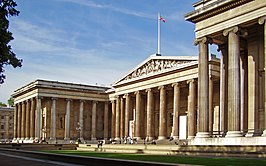
Back Bloomsbury Afrikaans بلومزبري Arabic بلومزبری AZB Блумсберы Byelorussian Блумсбъри Bulgarian Bloomsbury (Londres) Catalan Bloomsbury (Londýn) Czech Блумсбери CV Bloomsbury Welsh Bloomsbury (London) Danish
| Bloomsbury | |
|---|---|
Location within Greater London | |
| Population | 10,892 (2011 Census. Ward)[1] |
| OS grid reference | TQ299818 |
| London borough | |
| Ceremonial county | Greater London |
| Region | |
| Country | England |
| Sovereign state | United Kingdom |
| Post town | LONDON |
| Postcode district | WC1, NW1 |
| Dialling code | 020 |
| Police | Metropolitan |
| Fire | London |
| Ambulance | London |
| UK Parliament | |
| London Assembly | |
Bloomsbury is a district in the West End of London, part of the London Borough of Camden in England. It is considered a fashionable residential area, and is the location of numerous cultural, intellectual, and educational institutions. Bloomsbury is home of the British Museum, the largest museum in the United Kingdom, and several educational institutions, including University College London and a number of other colleges and institutes of the University of London as well as its central headquarters, the New College of the Humanities, the University of Law, the Royal Academy of Dramatic Art, the British Medical Association and many others. Bloomsbury is an intellectual and literary hub for London, as home of world-known Bloomsbury Publishing, publishers of the Harry Potter series, and namesake of the Bloomsbury Group, a group of British intellectuals which included author Virginia Woolf, biographer Lytton Strachey, and economist John Maynard Keynes.
Bloomsbury began to be developed in the 17th century under the Earls of Southampton,[2] but it was primarily in the 19th century, under the Duke of Bedford, that the district was planned and built as an affluent Regency era residential area by famed developer James Burton.[3] The district is known for its numerous garden squares, including Bloomsbury Square, Russell Square and Bedford Square.[4]
Bloomsbury's built heritage is currently protected by the designation of a conservation area and a locally based conservation committee. Despite this, there is increasing concern about a trend towards larger and less sensitive development, and the associated demolition of Victorian and Georgian buildings.[5]
- ^ "Camden Ward population 2011". Neighbourhood Statistics. Office for National Statistics. Archived from the original on 21 October 2016. Retrieved 20 October 2016.
- ^ The London Encyclopaedia, Edited by Ben Weinreb and Christopher Hibbert. Macmillan London Ltd 1983
- ^ Burton's St. Leonards, J. Manwaring Baines F.S.A., Hastings Museum, 1956.
- ^ Guide to London Squares Archived 12 October 2007 at the Wayback Machine. Retrieved 8 March 2007.
- ^ Owen Ward (11 January 2021). "Bloomsbury Conservation Area". BCAAC. Archived from the original on 23 January 2021. Retrieved 20 January 2021.





